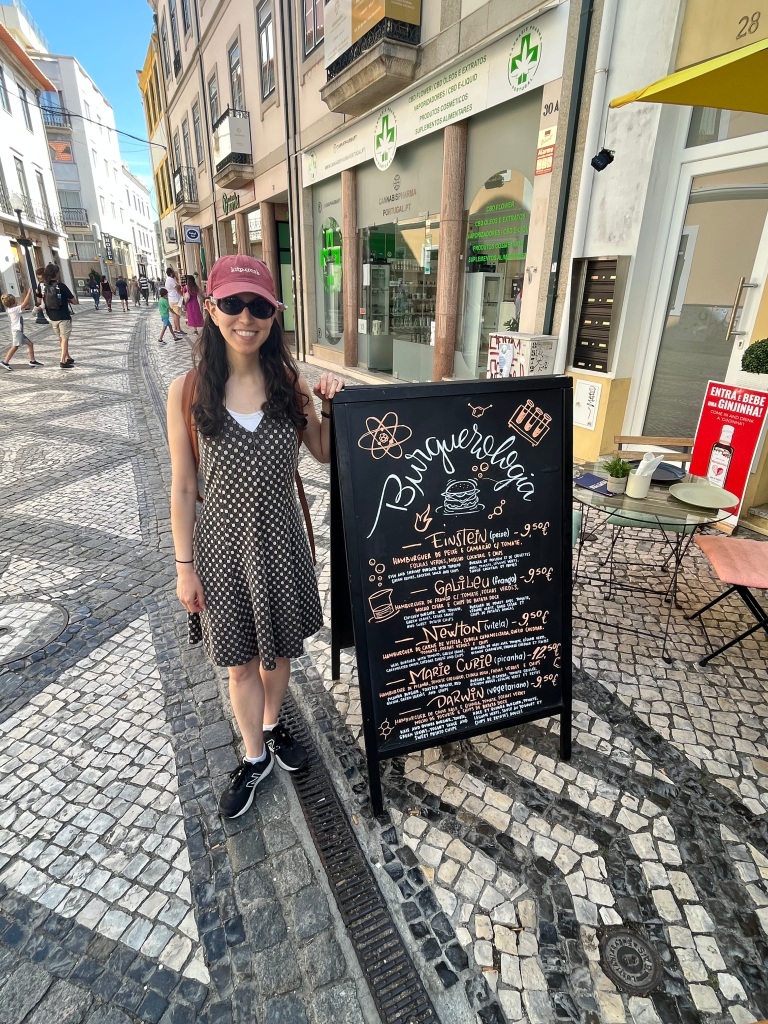My husband taught me how to pronounce the name of the city where I’d be presenting a talk late last July: Aveiro, Portugal. Having studied Spanish, I pronounced the name as Ah-VEH-roh, with a v partway to a hard b. But my husband had studied Portuguese, so he recommended Ah-VAI-roo.
His accuracy impressed me when I heard the name pronounced by the organizer of the conference I was participating in—Theory of Quantum Computation, or TQC. Lídia del Rio grew up in Portugal and studied at the University of Aveiro, so I bow to her in matters of Portuguese pronunciation. I bow to her also for organizing one of the world’s largest annual quantum-computation conferences (with substantial help—fellow quantum physicist Nuriya Nurgalieva shared the burden). But Lídia cofounded Quantum, a journal that’s risen from a Gedankenexperiment to a go-to venue in six years. So she gives the impression of being able to manage anything.
Watching Lídia open TQC gave me pause. I met her in 2013, the summer before beginning my PhD at Caltech. She was pursuing her PhD at ETH Zürich, which I was visiting. Lídia took me dancing at an Argentine-tango studio one evening. Now, she’d invited me to speak at an international conference that she was coordinating.
Not only Lídia gave me pause; so did the three other invited speakers. Every one of them, I’d met when each of us was a grad student or a postdoc.
Richard Küng described classical shadows, a technique for extracting information about quantum states via measurements. Suppose we wish to infer about diverse properties of a quantum state (about diverse observables’ expectation values). We have to measure many copies of
—some number
of copies. The community expected
to grow exponentially with the system’s size—for instance, with the number of qubits in a quantum computer’s register. We can get away with far fewer, Richard and collaborators showed, by randomizing our measurements.
Richard postdocked at Caltech while I was a grad student there. Two properties of his stand out in my memory: his describing, during group meetings, the math he’d been exploring and the Austrian accent in which he described that math.

Also while I was a grad student, Daniel Stilck França visited Caltech. Daniel’s TQC talk conveyed skepticism about whether near-term quantum computers can beat classical computers in optimization problems. Near-term quantum computers are NISQ (noisy, intermediate-scale quantum) devices. Daniel studied how noise (particularly, local depolarizing noise) propagates through NISQ circuits. Imagine a quantum computer suffering from a 1% noise error. The quantum computer loses its advantage over classical competitors after 10 layers of gates, Daniel concluded. Nor does he expect error mitigation—a bandaid en route to the sutures of quantum error correction—to help much.
I’d coauthored a paper with the fourth invited speaker, Adam Bene Watts. He was a PhD student at MIT, and I was a postdoc. At the time, he resembled the 20th-century entanglement guru John Bell. Adam still resembles Bell, but he’s moved to Canada.

Adam distinguished what we can compute using simple quantum circuits but not using simple classical ones. His results fall under the heading of complexity theory, about which one can rarely prove anything. Complexity theorists cling to their jobs by assuming conjectures widely expected to be true. Atop the assumptions, or conditions, they construct “conditional” proofs. Adam proved unconditional claims in complexity theory, thanks to the simplicity of the circuits he compared.
In my estimation, the talks conveyed cautious optimism: according to Adam, we can prove modest claims unconditionally in complexity theory. According to Richard, we can spare ourselves trials while measuring certain properties of quantum systems. Even Daniel’s talk inspired more optimism than he intended: a few years ago, the community couldn’t predict how noisy short-depth quantum circuits could perform. So his defeatism, rooted in evidence, marks an advance.
Aveiro nurtures optimism, I expect most visitors would agree. Sunshine drenches the city, and the canals sparkle—literally sparkle, as though devised by Elsa at a higher temperature than usual. Fresh fruit seems to wend its way into every meal.1 Art nouveau flowers scale the architecture, and fanciful designs pattern the tiled sidewalks.
What’s more, quantum information theorists of my generation were making good. Three riveted me in their talks, and another co-orchestrated one of the world’s largest quantum-computation gatherings. To think that she’d taken me dancing years before ascending to the global stage.
My husband and I made do, during our visit, by cobbling together our Spanish, his Portuguese, and occasional English. Could I hold a conversation with the Portuguese I gleaned? As adroitly as a NISQ circuit could beat a classical computer. But perhaps we’ll return to Portugal, and experimentalists are doubling down on quantum error correction. I remain cautiously optimistic.
1As do eggs, I was intrigued to discover. Enjoyed a hardboiled egg at breakfast? Have a fried egg on your hamburger at lunch. And another on your steak at dinner. And candied egg yolks for dessert.
This article takes its title from a book by former US Poet Laureate Billy Collins. The title alludes to a song in the musical My Fair Lady, “The Rain in Spain.” The song has grown so famous that I don’t think twice upon hearing the name. “The rain in Portugal” did lead me to think twice—and so did TQC.
With thanks to Lídia and Nuriya for their hospitality. You can submit to TQC2024 here.





